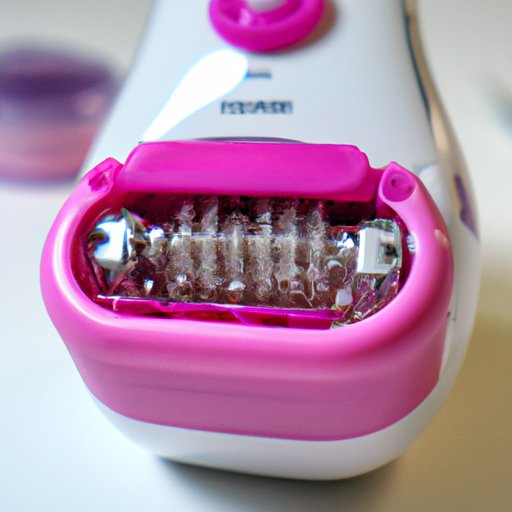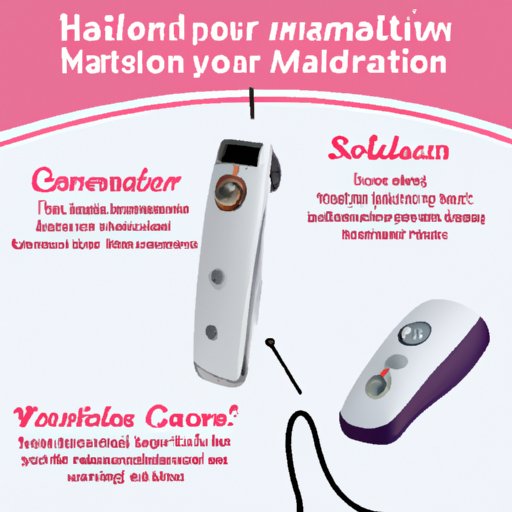Introduction
Epilation is a form of hair removal that involves plucking individual hairs from the root. This method of hair removal is becoming increasingly popular due to its long-lasting results and convenience. An epilator is a device used to perform epilation. This article will explore the anatomy of an epilator, provide a step-by-step guide to using one, discuss the pros and cons of epilation, debunk common myths, describe the different types of epilators, explain the science behind epilation, and offer tips for getting the most out of your epilator.

Anatomy of an Epilator: Exploring How It Works
Epilators come in many shapes and sizes, but they all have the same basic components. The head of the epilator consists of a rotating disc that is covered in tiny tweezers. The tweezers are designed to grip onto the hair and pull it out from the root. The motor is the power source of the epilator and drives the rotating disc. Additionally, some epilators may also have a light source which helps you see where you’re epilating.
The way an epilator works is simple. When the motor is switched on, the rotating disc starts to spin and the tweezers open and close in rapid succession. As the tweezers open, they catch hold of the hairs and when they close, they pluck them out from the root. This process is repeated over and over until the desired area has been epilated.
A Step-by-Step Guide to Using an Epilator
Using an epilator can be intimidating for those who are new to it, but it doesn’t have to be. With this step-by-step guide, you’ll be epilating like a pro in no time!
1. Prepping your skin: Before you start epilating, it’s important to prep your skin. Make sure you exfoliate the area beforehand to get rid of any dead skin cells, as this will help prevent ingrown hairs. You should also make sure your skin is clean and dry before you begin epilating.
2. Setting up the epilator: Once your skin is prepped, it’s time to set up the epilator. Depending on the model you have, there may be several settings you can adjust such as the speed or intensity. Make sure to read the instructions carefully so you know how to use all the features of your epilator.
3. The epilation process: Now that the epilator is ready to go, it’s time to start epilating! Hold the epilator at a 90-degree angle to your skin and move it in the opposite direction of hair growth. Try to keep the skin taut as you move the epilator to ensure the best results. Take your time and be gentle, as going too quickly can cause irritation.
4. Post-epilation care: After you’ve finished epilating, it’s important to take care of your skin. Apply a soothing lotion or moisturizer to the area to help with any redness or irritation. It’s also a good idea to exfoliate regularly to help prevent ingrown hairs.

The Pros and Cons of Epilation
Epilation has both advantages and disadvantages. Here are some of the pros and cons of epilation to consider before deciding if it’s right for you.
Advantages: Epilation offers long-lasting results. Unlike other methods of hair removal, epilation removes the hair from the root, meaning it takes longer for the hair to grow back. Additionally, epilation is relatively quick and easy to do, making it a convenient option for those looking for a low-maintenance hair removal routine. Finally, epilation is generally painless when done correctly.
Disadvantages: One of the biggest drawbacks of epilation is that it can be painful. Some people find the sensation too uncomfortable to bear, while others may only experience mild discomfort. Additionally, epilation can cause redness and irritation in some cases. Finally, epilation may not be suitable for those with sensitive skin.
Common Myths About Epilators Debunked
There are many misconceptions about epilators that can deter people from trying them. Here are three of the most common myths about epilators debunked.
Myth 1: Epilation causes permanent damage. False. While epilation can cause temporary redness and irritation, it does not cause permanent damage. In fact, epilation is one of the safest methods of hair removal available.
Myth 2: Epilation is only suitable for certain areas of the body. False. Epilation can be used on almost any area of the body, including the face, legs, arms, underarms, chest, and stomach.
Myth 3: Epilation causes more hair to grow back. False. Epilation does not cause more hair to grow back. In fact, regular epilation can actually reduce the amount of hair that grows back over time.
What are the Different Types of Epilators?
There are three main types of epilators on the market: spring epilators, rotary epilators, and tweezers-based epilators. Let’s take a look at each type in more detail.
Spring epilators: Spring epilators are the oldest type of epilator and feature a metal coil that is wound around a central axis. When the coil is released, it rapidly unwinds and plucks out the hairs. Spring epilators are usually more affordable than other types, but they can be quite painful to use.
Rotary epilators: Rotary epilators feature rotating discs that are covered in tiny tweezers. These tweezers open and close in rapid succession to grasp and remove the hairs. Rotary epilators are more expensive than spring epilators, but they are also less painful.
Tweezers-based epilators: Tweezers-based epilators are the most advanced type of epilator. These devices feature two sets of tweezers that work together to pull out the hairs from the root. Tweezers-based epilators are the most expensive type, but they are also the least painful.

Understanding the Science Behind Epilation
To understand how epilation works, it’s important to understand the hair growth cycle. Hair grows in three stages: anagen (growth phase), catagen (transitional phase), and telogen (resting phase). During the anagen phase, the hair is actively growing and can easily be removed. During the catagen and telogen phases, the hair is not actively growing and is harder to remove. This is why it’s important to epilate during the anagen phase for optimal results.
When an epilator is used, the tweezers grab onto the hairs and pull them out from the root. This disrupts the hair growth cycle and prevents the hair from growing back for several weeks. Over time, the hairs become finer and more sparse due to the disruption of the hair growth cycle.
Tips for Getting the Most Out of Your Epilator
Epilation can be intimidating for those who are new to it, but there are several things you can do to get the most out of your epilator.
Cleaning and maintenance tips: It’s important to keep your epilator clean and free of debris to prevent irritation and infection. After each use, make sure to wipe the head of the epilator with a damp cloth and then let it air-dry. Additionally, make sure to replace the tweezers every few months to ensure optimal performance.
Pain management techniques: If you find epilation to be painful, there are several things you can do to minimize the discomfort. Taking a warm bath or shower before epilating can help soothe the skin and reduce pain. Additionally, applying numbing cream to the area can also help reduce the sensation.
Adjusting settings for different areas: Different areas of the body require different settings. For example, the face requires a gentler setting than the legs. Make sure to read the instructions carefully to determine which settings are best for your particular needs.
Conclusion
Epilation is a popular method of hair removal that offers long-lasting results. This article explored the anatomy of an epilator, provided a step-by-step guide to using one, discussed the pros and cons of epilation, debunked common myths, described the different types of epilators, explained the science behind epilation, and offered tips for getting the most out of your epilator. Whether you’re a seasoned epilator or just starting out, this article should give you all the information you need to get the most out of your epilator.
(Note: Is this article not meeting your expectations? Do you have knowledge or insights to share? Unlock new opportunities and expand your reach by joining our authors team. Click Registration to join us and share your expertise with our readers.)
